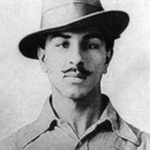Bhagat Singh is an important figure in the history of the Indian freedom movement. He was a revolutionary leader who was executed by the British. In this article, you can read all about Bhagat Singh’s contributions and role in the revolutionary freedom movement, for the Indian history segment of the UPSC syllabus.
Bhagat Singh Short Notes
Download PDF Here
| Candidates appearing for the exam may check the following links to strengthen their preparation: |
Bhagat Singh [Short Note]

Bhagat Singh was born into a Sikh family in 1907 in Lyallpur District, present-day Pakistan.
- Bhagat Singh’s family members were involved in the freedom struggle and he was drawn towards the Indian independence movement from a very young age.
- As a child, he defied the British government by burning textbooks recommended by it.
- Initially, he supported Mahatma Gandhi and the Non-Cooperation Movement.
- However, when Gandhiji withdrew the movement in the wake of the Chauri Chaura incident, Bhagat Singh turned to revolutionary nationalism.
- He was particularly affected by the Jallianwala Bagh massacre (1919) and the violence against unarmed Akali protestors at Nankana Sahib (1921).
- Inspired by leftist writings he read widely, Bhagat Singh was an atheist and against capitalism.
Bhagat Singh’s Revolutionary Activities/Contributions to Freedom Struggle
Although there have been many leaders from the revolutionary mould, Bhagat Singh’s name is always first quoted when talking about revolutionary freedom fighters of India.
- In 1926, he founded the Naujawan Bharat Sabha.
- This organisation aimed to encourage revolution against British rule by rallying the peasants and workers.
- Bhagat Singh served as the organisation’s secretary.
- In 1928, he established the Hindustan Socialist Republican Association (HSRA) along with Sukhdev, Chandrashekhar Azad and others.
- Lala Lajpat Rai died in 1928 as a result of injuries sustained in a police lathi charge on the orders of a Superintendent of Police, James Scott.
- Bhagat Singh and his revolutionary friends decided to avenge the death of the dear leader.
- However, in a case of mistaken identity, they assassinated another police official J P Saunders.
- This was part of the Lahore Conspiracy Case.
- After this incident, Bhagat Singh fled from Lahore and made changes to his appearance.
- Central Assembly Bombing Case
- Bhagat Singh was also involved in this case.
- On 8th April 1929, Bhagat Singh and Batukeshwar Dutt threw a bomb in the Central Assembly at Delhi, from the Visitors’ Gallery.
- They also threw pamphlets and raised pro-revolutionary slogans.
- Both the revolutionaries courted arrest since they wanted to spread their message of revolution and anti-imperialism, and needed a platform for it.
- Nobody was hurt in the incident, and it was never their intention to cause physical harm to anyone.
- Their stated aim was ‘to make the deaf hear’.
- Bhagat Singh was the mastermind behind the incident, and he was inspired by Auguste Vaillant, a French anarchist, who was executed by France for a similar incident in Paris.
- In the trial that ensued, both Bhagat Singh and BK Dutt were sentenced to transportation for life.
- For more on the Central Assembly Bombing Case, check This Day in History dated 8th April.
- In the meanwhile, the murder case of J P Saunders also came up and Bhagat Singh was linked to that case as well.
Bhagat Singh Execution
Bhagat Singh was arrested and charged in the Saunders murder case, along with Rajguru, Sukhdev and others.
- This trial commenced in July 1929.
- In the Lahore prison where they were lodged, the young leaders started a hunger strike demanding better treatment as they were supposed to be political prisoners.
- They were met by many leaders including Jawaharlal Nehru, who expressed pain on seeing their distress.
- Bhagat Singh fasted for 116 days after which he ended it at the request of his father and Congress leaders.
- The trial, needless to say, was one-sided and Bhagat Singh, along with Rajguru and Sukhdev were sentenced to death.
- The trial and the subsequent sentence drew widespread condemnation from many quarters.
- Many national leaders requested a reduced sentence but to no avail.
- The trio was ordered to be hanged on 24 March 1931 but the sentence was carried out a day earlier at the Lahore Jail. After the hanging, their mortal remains were cremated in secret.
- It is said that Bhagat Singh cried ‘Down with British imperialism’ as he was hanged.
- This execution evoked strong reactions from the Indian people, particularly youngsters, and many were motivated to join the freedom struggle.
- 23rd March is observed as ‘Martyrs’ Day’ or ‘Shaheed Diwas’ or ‘Sarvodaya Day’ in honour of Bhagat Singh, Rajguru and Sukhdev.
Bhagat Singh Quotes
Bhagat Singh’s many quotes are famous and some of them can be used in the UPSC Mains exam.
- They may kill me but they cannot kill my ideas. They can crush my body, but they will not be able to crush my spirit.
- Bombs and pistols do not make a revolution. The sword of revolution is sharpened on the whetting stone of ideas.
- May the sun in his course visit no land freer, happier, more lovely, than this our own country.
- But mere faith and blind faith is dangerous: it dulls the brain and makes a man reactionary.
- Revolution is an inalienable right of mankind. Freedom is an imperishable birthright of all. Labour is the real sustainer of society.
Frequently asked Questions about Bhagat Singh
What is Bhagat Singh known for?
What is the legacy of Bhagat Singh?
What was Bhagat Singh’s slogan?
What were the last words of Bhagat Singh?

Comments